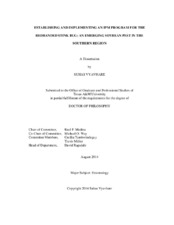| dc.description.abstract | Redbanded stink bug (RBSB), (Piezodorus guildinii Westwood) has recently emerged as an economic pest of soybean, Glycine max (L.) Merrill in the southern US. Having only recently emerged as a pest in the US, little information exists on RBSB in this country. Information on RBSB life history is needed to provide the basis for development of an effective management plan for this Neotropical pentatomid. This dissertation research was undertaken to gather information which will help achieve the long term goal of developing an integrated pest management (IPM) program for RBSB.
Soybean field surveys conducted over three years across the Upper Gulf Coast of Texas showed that RBSB has become the most abundant stink bug species attacking soybean in this region, accounting for 65% of the entire population of the stink bug pest complex. Field cage experiments showed that highest yield losses from RBSB occurred when soybeans at R5-R6 stages were infested. Our data also showed that a relatively high RBSB density (8 RBSB adults/0.3 m) during R4-R5 stage soybean triggered development of delayed maturity indicated by green leaf retention. In addition, field experiments conducted to determine if reduced pod load or alteration of sink-source ratio is involved in delayed maturity showed no relationship between reduced pod load and occurrence of soybean delayed maturity. However, RBSB density was found to have a significant positive correlation to the occurrence of soybean delayed maturity. These findings suggest that RBSB-induced soybean delayed maturity may not be solely due to reduced pod load or altered sink-source ratio, but additional mechanisms also may be involved. Finally, results from an insecticide field trial and laboratory bioassays showed that RBSBs are more susceptible to neonicotinic and pyrethroid insecticides than to the widely used organophosphate, acephate. This dissertation research has provided valuable information in regard to RBSB and soybean, which will help develop, and establish an IPM program for this emergent pest of US soybean. Development of an IPM program will reduce dependence on chemical insecticides for RBSB management. Reductions in insecticide use will eventually benefit the environment and human health. | en |


